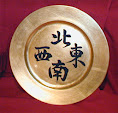The latest instalment, issue No.8, however, is a great issue! Amongst the highlights:
☞ A 33-page space-fantasy solo adventure set in New Khazan, consisting of 141 paragraphs of gung ho adventure, with outer space random encounters such as mining drones and space syrens, basic spaceship stats, a simple space travel system, etc. Lots of material that you may fruitfully scavenge for your own space-fantasy games!
☞ A 16-page GM wilderness adventure. This is particularly noteworthy as T&T adventures tend to stick to the dungeon bash model.
☞ A fully-fledged alternative combat system for Tunnels & Trolls, by Dan Hembree (TrollsZine's editor), based on the T&T Saving Rolls (SR) mechanism. At 9 pages, this is quite a hefty article. Now, since I have myself got rid of the standard T&T mêlée combat system for my own T&T homebrew, I have read Dan's article with utmost interest. Here are my thoughts.
Dan's alternative combat system is based on man-to-man combat, and not on T&T's seminal "each side totals all" mechanism. As a result, each combatant needs:
- an attribute to base the SR upon,
- a difficulty level for said SR
The difficulty level for the combat SRs is based upon the opponent's level or upon a monster's MR/10. I really don't like this— in almost all frp games, determining whether a combatant hits or not is based on their fighting capability, not their opponent's: in classic fantasy, it's based on the combatant's level, in D100-based games, on the combatant's skill, etc. In my homebrew, the SR actually doesn't have a difficulty level: each combatant rolls their SR, and then the actual difficulty levels reached are compared, so as to create a kind of opposed SR mechanism.
The cool thing, however, is that Dan's system allows for simultaneous combat results with weapon-dependent damage, part of which is stopped by armour, whereas my system does not take weapon and armour into account: I have opted for a more abstract system, à la HeroQuest.
Anyway, whatever criticisms I may have, I still think Dan's system is definitely worth a try, even if it kind of makes T&T mêlée combat closer to the D&D approach, where armour class (which depends on the opponent and not on the combatant) does influence the combatant's hit probabilities.













No comments:
Post a Comment